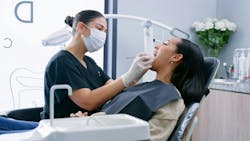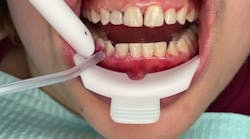The importance of properly recording oral pathologies for dental hygienists
One of dental hygienists’ critical roles is to thoroughly examine and document abnormalities or lesions in the oral cavity. Proper recording of oral pathologies is essential not only for diagnosis and treatment but also for monitoring changes over time.
Understanding how to accurately describe oral lesions ensures that we provide the best care for our patients, collaborate effectively with other health-care providers, and identify severe conditions early.
Why accurate recording matters
Accurately recording oral lesions supports proper diagnosis and treatment planning, which helps dental professionals decide if a lesion is harmless or needs further attention. Clear documentation allows us to track changes, such as size or appearance, which may signal healing or new concerns.
This attention to detail ensures better patient care and strengthens communication between health-care providers. From a legal and ethical standpoint, thorough documentation protects the dental hygienist and the practice, providing evidence of observations and actions taken during a patient’s visit.1,2
How to record oral pathologies
When recording oral pathologies, specific details must be included to create a complete and valuable report. Here are some key aspects to cover:
1. Location of lesions: Describe the location using anatomical landmarks. For example, note whether the lesion is on the buccal mucosa, gingiva, tongue, or palate. The precise location helps pinpoint the lesion's relevance and possible causes, such as irritation from a dental appliance or trauma.
2. Number of lesions: Is the lesion solitary, or are there multiple lesions? Multiple lesions may indicate a systemic issue, such as a viral infection, while a solitary lesion could be a sign of localized trauma.
3. Size of lesions: Always measure lesions in millimeters. This allows accurate monitoring and comparison over time, especially if the lesion changes in size during follow-up visits. Use your dental probe as a measuring tool.
4. Appearance of lesions: Describe the lesion's color, surface texture, borders, consistency, and palpation findings. For example:
- Color: Red, white, or brown lesions indicate different conditions. A red lesion may suggest inflammation, while a white lesion could indicate hyperkeratosis or leukoplakia.
- Surface texture: Is the lesion smooth, rough, or ulcerated? Each texture can give clues to its nature. For instance, a rough surface may indicate a verruca, while an ulcerated surface might suggest trauma or infection.
- Borders: Are the borders well-defined or poorly defined? A well-defined lesion is typically easier to manage, whereas a poorly defined lesion could raise concern for more severe conditions, such as a malignancy.
- Consistency: Is the lesion soft, firm, or indurated? Firm or indurated lesions might need closer examination as they could indicate a more serious underlying condition.
- Mobility: Is the lesion fixed or movable upon palpation?
- Palpation findings: Is the lesion tender to palpation? This helps determine whether it’s associated with pain or inflammation.
Classification of lesions
Understanding the type of lesion helps form a more accurate description. Lesions can be classified by their surface elevation, characteristics, or attachment.
Raised lesions
- Papule: A small, solid elevation less than 5 mm in diameter
- Nodule: A large elevation, typically 5 mm or more
- Verruca: A rough, wart-like lesion caused by HPV
- Torus: A bony outgrowth often found on the jaw
Flat lesions
- Macule: A small, flat change in pigmentation
- Patch: A large flat area that could be discolored or pigmented
Depressed lesions
- Ulcer: An open sore involving deep layers of tissue, often painful
- Erosion: A superficial loss of tissue, typically painless
By attachment
- Pedunculated: Lesion attached by a narrow stalk (e.g., some papillomas).
- Sessile: Lesion with a broad base of attachment (most common).
Additional characteristics
Further important details include whether the lesion is exophytic or endophytic. Also, note if it appears hemorrhagic or has any crusting, as with a ruptured blister.
Dental professionals must know how to properly record oral pathologies. Accurate documentation helps with diagnosis, treatment, and follow-up while providing a precise communication tool between health-care providers.
Dental hygienists play a critical role in ensuring comprehensive patient care by thoroughly describing lesions based on their location, size, number, appearance, and other characteristics.
References
1.Kondori I, Mottin RW, Laskin DM. Accuracy of dentists in the clinical diagnosis of oral lesions. Quintessence Int. 2011;42(7):575-577.
2. Bacci C, Donolato L, Stellini E, Berengo M, Valente M. A comparison between histologic and clinical diagnoses of oral lesions. Quintessence Int. 2014;45(9):789-794. doi:10.3290/j.qi.a32440
About the Author

Andreina Sucre, MSc, RDH
Andreina Sucre, MSc, RDH, is an international dentist, oral pathology, and oral surgery specialist practicing dental hygiene in Miami, Florida. A passionate advocate for early pathological diagnosis, she empowers colleagues through lectures focused on oral pathologies. Andreina spoke on this topic at the 2024 ADHA Annual Conference, 2023 RDH Under One Roof, and she writes about oral pathology for RDH magazine. Committed to community outreach, she educates non-native English-speaking children on oral health and actively volunteers in dental initiatives.


